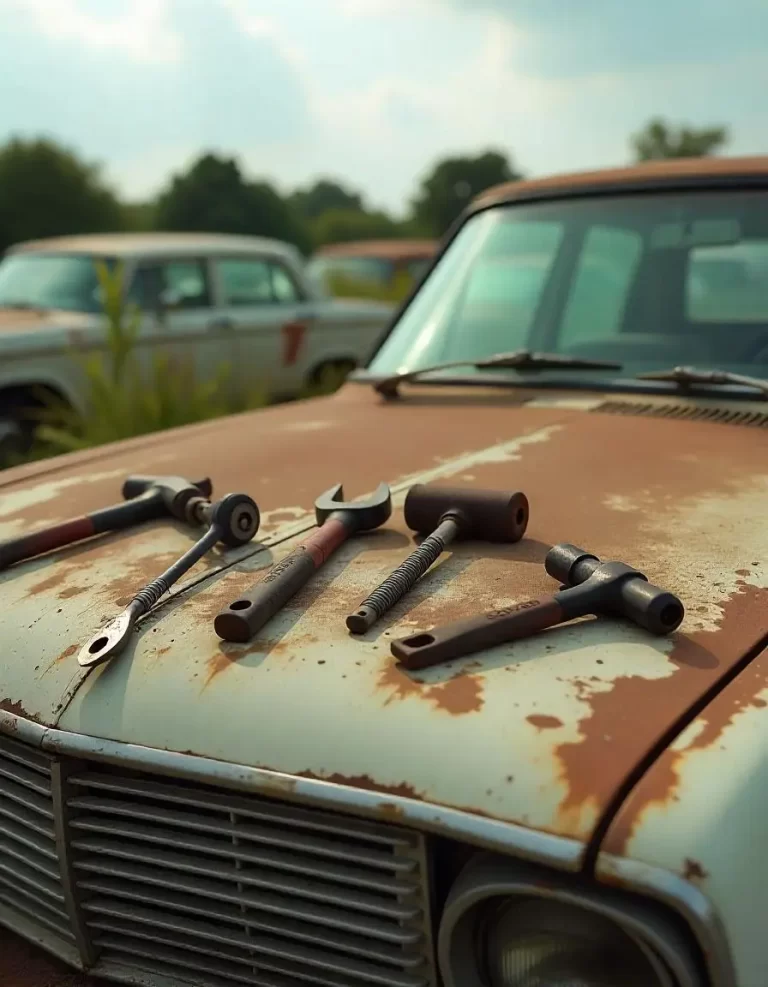
The Ultimate Guide to Car Exhaust Leak Repair. A properly functioning exhaust system is vital for your vehicle’s performance, safety, and environmental impact. When an exhaust leak develops, it not only reduces your car’s efficiency but also poses potential health risks from harmful fumes. This comprehensive guide is designed to walk you through the essentials of Car Exhaust Leak Repair. Whether you’re a DIY enthusiast or someone who prefers to call in a professional, you’ll find detailed insights, practical tips, and step-by-step techniques that will help you navigate the repair process with confidence and ease.
Understanding Car Exhaust Leak Repair Basics
Before diving into the repair process, it’s important to understand the fundamentals of Car Exhaust Leak Repair. The exhaust system is responsible for directing harmful gases away from the engine and safely releasing them into the atmosphere. Over time, due to factors like rust, corrosion, or physical damage, leaks can occur. These leaks might be small, causing minor performance issues, or significant enough to affect your engine’s overall efficiency.
Leaks in the exhaust system are often caused by a combination of wear and tear, exposure to moisture, and extreme temperature changes. The Car Exhaust Leak Repair process typically involves identifying the leak, assessing the damage, and deciding whether a quick fix or a complete component replacement is necessary. In many cases, a minor leak can be temporarily patched using high-temperature epoxy or exhaust sealant, but more severe damage might require professional intervention.
Recognizing Signs of Car Exhaust Leak Repair Issues
The first step toward effective Car Exhaust Leak Repair is recognizing the signs that indicate a leak might be present. Early detection is crucial, as even a small leak can lead to bigger problems down the road. Common symptoms include:
- Unusual Noises: If you hear a ticking, hissing, or tapping sound coming from under your car, it could be an indication that there’s an exhaust leak. (Read More: Best AC Car Freon Types for Maximum Cooling).
- Decreased Fuel Efficiency: A drop in fuel economy can signal that your engine is working harder than usual to compensate for a leaking exhaust system.
- Strange Smells: The smell of exhaust fumes inside or near your vehicle is a strong indicator that harmful gases are escaping before they reach the tailpipe.
- Visible Damage or Corrosion: A visual inspection might reveal rust or holes in the exhaust components, which are clear signs that repair is needed.
- Poor Engine Performance: A noticeable decrease in power or acceleration might be linked to an exhaust leak disrupting the proper back pressure needed for efficient engine function.
By understanding these warning signs, you can take timely action to address the issues before they escalate further.
DIY Car Exhaust Leak Repair Techniques
For those who enjoy hands-on projects, many aspects of Car Exhaust Leak Repair can be tackled at home with the right tools and a bit of know-how. DIY repair methods can be both cost-effective and satisfying when done correctly. Here are some steps to consider if you choose to attempt a repair yourself:
- Locate the Leak: Begin by visually inspecting your exhaust system. Look for rust, holes, or any areas where the metal appears worn. You can also use a piece of cloth to detect escaping air by feeling for movement near suspected leak points.
- Clean the Area: Use a wire brush or sandpaper to clean the area around the leak. Removing rust and debris is essential for ensuring a strong bond with any sealants or repair materials.
- Apply High-Temperature Epoxy or Sealant: There are several products available that are specifically designed for exhaust repairs. Apply a generous layer of the sealant over the damaged area. Allow it to cure as per the manufacturer’s instructions.
- Reinforce with Exhaust Tape or Wraps: For added security, you might consider wrapping the area with exhaust repair tape. This provides extra insulation and helps maintain the pressure within the system.
- Test the Repair: Once the sealant or epoxy has fully cured, start your engine and listen carefully. If the noise has diminished and performance seems improved, your repair is likely successful.
Remember, while DIY methods can be effective for minor leaks, they may not provide a permanent solution for more significant damage.
Safety Measures for Car Exhaust Leak Repair
Safety is paramount when undertaking any form of Car Exhaust Leak Repair. Working under a car or near an exhaust system can expose you to harmful fumes and hot surfaces. To ensure a safe repair process, consider these precautions:
- Wear Protective Gear: Always use gloves, safety glasses, and if possible, a mask to protect yourself from inhaling dust and fumes. (Read More: Car Auctions vs. Dealerships: Where to Find the Best Deals in 2024).
- Work in a Well-Ventilated Area: If you’re working in a garage, make sure the area is well-ventilated. Exhaust fumes can be hazardous if inhaled in large quantities.
- Use the Right Tools: Ensure that you have the appropriate tools and that they are in good working condition. Using faulty equipment can increase the risk of injury.
- Follow Manufacturer Instructions: Whether you’re using an epoxy, sealant, or any other repair product, follow the manufacturer’s guidelines to ensure proper usage and maximum effectiveness.
- Cool Down the Exhaust System: Never work on an exhaust system immediately after driving, as the components can be extremely hot. Allow the system to cool down completely before starting your repair.
These safety tips are essential for avoiding injuries and ensuring that your repair work proceeds smoothly.
Essential Tools and Materials for Car Exhaust Leak Repair

Successful Car Exhaust Leak Repair depends on having the right set of tools and materials at your disposal. Here’s a list of items that can help you achieve a professional-grade repair at home:
- Wire Brush or Sandpaper: To clean away rust and debris from the damaged area.
- High-Temperature Epoxy or Exhaust Sealant: Specially formulated to withstand the extreme heat generated by your exhaust system.
- Exhaust Repair Tape: A durable tape that provides additional sealing and insulation.
- Gloves and Safety Glasses: Protective gear to keep you safe during the repair process.
- Jack and Jack Stands: If you need to raise your vehicle to access the exhaust system, a reliable jack and stands are essential.
- Wrenches and Socket Set: Useful for removing any components that might be obstructing your access to the leak.
- A Digital Camera or Smartphone: To take photos of the damaged area before and after your repair, which can be helpful if you decide to consult a professional later on.
Having these tools on hand not only makes the Car Exhaust Leak Repair process more efficient but also helps ensure that the repair is done correctly. (Read More: Why Christian Brothers Automotive Stands Out in the Auto Repair Industry in 2024).
When to Consider Professional Car Exhaust Leak Repair Services
While many leaks can be addressed with DIY techniques, there are times when it’s best to call in an expert. Complex issues or significant damage to your exhaust system may require the specialized skills and equipment that only a professional mechanic can offer. Consider professional Car Exhaust Leak Repair services if:
- The Leak is Extensive: Large holes or widespread corrosion might be beyond the scope of a simple patch-up job.
- You’re Unsure About the Extent of the Damage: If the leak is in a hard-to-reach area or if you suspect that there might be additional underlying issues, a professional evaluation is recommended.
- DIY Repairs Haven’t Worked: If you’ve attempted a repair and the symptoms persist, it might indicate a more complex issue that requires professional intervention.
- You Lack the Necessary Tools or Experience: Professional mechanics have access to specialized tools and diagnostic equipment that can accurately pinpoint the problem and provide a long-lasting repair.
By knowing when to step back and call a professional, you can avoid further complications and ensure that your vehicle is safe to drive.
Understanding Cost and Time Investment in Car Exhaust Leak Repair
Budget and time are important considerations in any repair project. The cost of Car Exhaust Leak Repair can vary significantly depending on the severity of the leak and whether you opt for a DIY solution or professional service. DIY repairs tend to be less expensive, often requiring just the purchase of repair materials and tools, while professional repairs might involve labor costs that can add up quickly.
For a DIY repair, you might expect to spend anywhere from $20 to $100 on materials, whereas a professional repair could range from $150 to $500 or more, especially if major components need replacement. Time is another factor; a DIY repair might take a couple of hours to complete, but if the damage is extensive or if you encounter unexpected issues, it could take longer. On the other hand, professional shops might complete the repair within a few hours to a day, depending on their schedule and the complexity of the job.
Maintaining Your Vehicle After Car Exhaust Leak Repair

After completing your Car Exhaust Leak Repair, ongoing maintenance is key to preventing future issues. Regular inspections and timely repairs can extend the life of your exhaust system and ensure optimal performance. Here are some maintenance tips to consider:
- Regular Visual Inspections: Periodically check your exhaust system for signs of rust, corrosion, or physical damage. Early detection can save you time and money.
- Routine Cleaning: Keep the exhaust system clean by removing debris and buildup that could contribute to corrosion. A simple cleaning can help maintain the integrity of the repair.
- Monitor Your Vehicle’s Performance: Stay alert to any changes in fuel efficiency, engine performance, or unusual noises. These can be early indicators that another repair might be needed.
- Scheduled Maintenance: Follow your vehicle’s maintenance schedule as outlined by the manufacturer. Regular service appointments can help identify potential issues before they become serious.
- Weather Considerations: If you live in an area with harsh winters or salty roads, be extra vigilant. Moisture and salt are notorious for accelerating rust and corrosion on metal components.
- Professional Check-Ups: Even if you’ve successfully completed a DIY repair, it’s a good idea to have a professional mechanic inspect your work periodically. They can provide an objective assessment and catch any issues that might have been overlooked.
By integrating these maintenance practices into your routine, you can help ensure that your exhaust system remains in good condition for years to come.
Each of these sections offers valuable insights and practical advice for tackling Car Exhaust Leak Repair, empowering you with the knowledge to handle the repair process—whether you’re rolling up your sleeves for a DIY fix or deciding when to enlist the help of a professional mechanic.




